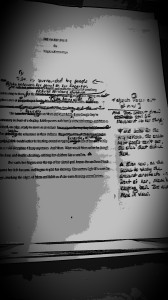When I was in college and started doing serious writing, which always means doing serious revising, I devised a slate of symbols to indicate spots where text should be inserted. Most of us use the asterisk for this purpose. However, if you’re making substantial changes, you need more than one symbol. I would start with an asterisk, then go to two asterisks conjoined like a mutant snowflake. Three asterisks seemed like too much, so I went on to a sort of cross with two horizontal lines, then a filled-in triangle, and finally a filled-in circle. With these symbols, I could make five insertions per page. Very occasionally, I would need even more, in which case I used capital letters with circles around them.
I am now in the process of revising a manuscript, and today my goal was to combine two chapters, taking out some material and bolstering an under-developed plot. This is precisely the sort of revising that involves lots of insertions, so I fell back on the tried and true approach described above.
 I doctored this image because the manuscript isn’t yet ready to be read by the general public, but I think you can still make out the many insertions, each with its own symbol.
I doctored this image because the manuscript isn’t yet ready to be read by the general public, but I think you can still make out the many insertions, each with its own symbol.
It felt really good to return to this method of revision. There was a muscle memory to it, for my hand but also for my brain. It seems silly to feel invested in an assortment of symbols, and not especially original ones either, but having so many ways to indicate that text should be added is a way of giving myself permission to make major changes to a text.
Once we craft sentences and paragraphs, it is painful to break them open, shift around their parts, bring in new material, and delete forever much-loved turns of phrase. But this is how writing gets to be good. This is how a subject, verb, and a handful of other parts of speech transform into phrases stitched on throw pillows, epigraphs for the next generation of authors, or, simply, words to live by. It is in revision–serious, phrase-rending, up-to-five-insertions-per-page revision–that writing becomes art.
